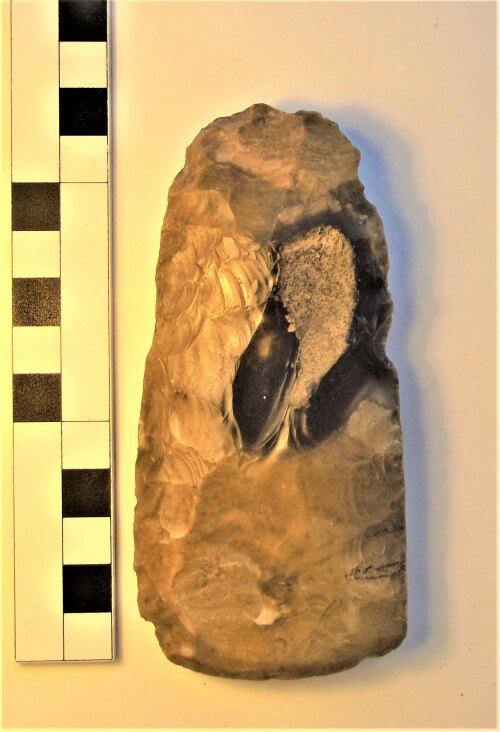
Rights Holder: Norfolk County Council
CC License: ![]()
Image use policy
Our images can be used under a CC BY attribution licence (unless stated otherwise).
AXE
Unique ID: NMS-BD3EF4
Object type certainty: Certain
Workflow
status: Awaiting validation ![]()
Part-polished axe, of mottled grey and black flint, now patinated mid-brown. The axe is bifacially knapped to form a sub-trapezoidal plan with a rounded butt and a thin, lenticular cross section, a hollow of thin, worn cortex remains to the dorsal face to one side, near to the butt, this is surrounded by black flint. The entire axe is bifacially worked with well struck, confident invasive and overlapping flake scars apart from the cortex, the only unmodified surface extant. The broadest point has been ground and polished to a sharp cutting edge, this is in good condition with only a few tiny chips apart from a recent, small flake that has removed one corner, this recent damage shows the original colour of the flint to have been a shade greyer than the rest of patinated surface. A few similar flakes have come off one side of the butt, though this has had little effect to overall original shape.
An unusual feature of this axe is the thickness of the butt compared to the relative thinness of the rest of the axe, another being the very straight lateral edges are not abraded and blunted to any great degree, all these aspects would have made it almost impractical as a work-a-day axe, the thickest part to most Neolithic axes is at the mid-point, making an effective wedge point when inserted into the socket in the wood handle. The edges are usually ground to remove the sharpness and to ensure the flint doesn’t cut into the top and bottom of the socket in the handle and initiate a longitudinal split of the grain of the wood, this example is still relatively sharp, though they are very lightly blunted. The last feature is the thinness of the axe towards the cutting edge, this would have been a weak point when in use and it wouldn’t have taken much to break it in half, a slight twist to the use-impact would have been enough to overload this thin axe.
It is therefore very likely that this represents a copy of one of the early copper/copper alloy flat axes, but made in flint, of likely ceremonial function over practical use. Other examples recorded are: NMS-D38255, NMS-62DC05, NMS-92F628 and a very elongated example CORN-BA9E64.
Recorded examples of early copper (alloy) axes these were likely copies of are: NMGW-AD63BF, NMGW-0670CA, LANCUM-566167 and ESS-7D18D8.
Find of note status
This has been noted as an interesting find by the recorder.
Subsequent actions
Subsequent action after recording: Returned to finder
Chronology
Broad period: NEOLITHIC
Subperiod from: Late
Period from: NEOLITHIC
Subperiod to: Early
Period to: BRONZE AGE
Date from: Circa 3000 BC
Date to: Circa 1501 BC
Dimensions and weight
Quantity: 1
Length: 118 mm
Width: 56 mm
Thickness: 21.5 mm
Weight: 109 g
Discovery dates
Date(s) of discovery: Wednesday 1st January 2020 - Tuesday 4th February 2020
Personal details
This information is restricted for your access level.
Other reference numbers
SMR reference number: 65333
Other reference: INDCDDJD04022020JG
Materials and construction
Primary material: Flint
Manufacture method: Ground/polished
Completeness: Complete
Spatial metadata
Region: Eastern (European Region)County or Unitary authority: Norfolk (County)
District: Great Yarmouth (District)
Parish or ward: Caister-on-Sea (Civil Parish)
References cited
No references cited so far.
Similar objects

Find number: NMS-D38255
Object type: AXE
Broadperiod: NEOLITHIC
Part Polished Flint Axe.
Elongated, sub-trapezoidal plan with a thin lenticular cross section, of unpatinated black flint with a few pal…
Workflow: Published![]()

Find number: NMS-511C76
Object type: AXEHEAD
Broadperiod: NEOLITHIC
Butt end of a thin butted polished flint axe, broken in antiquity and bifacially reshaped to a crude point. Length 85.5mm. Width 33mm. Thickn…
Workflow: Published![]()

Find number: NMS-F27DB7
Object type: AXE
Broadperiod: NEOLITHIC
Elongated, thin butted flaked axe: - of mottled dark grey and light grey flint with a slight orange patination to the surfaces, this orange is…
Workflow: Awaiting validation![]()





